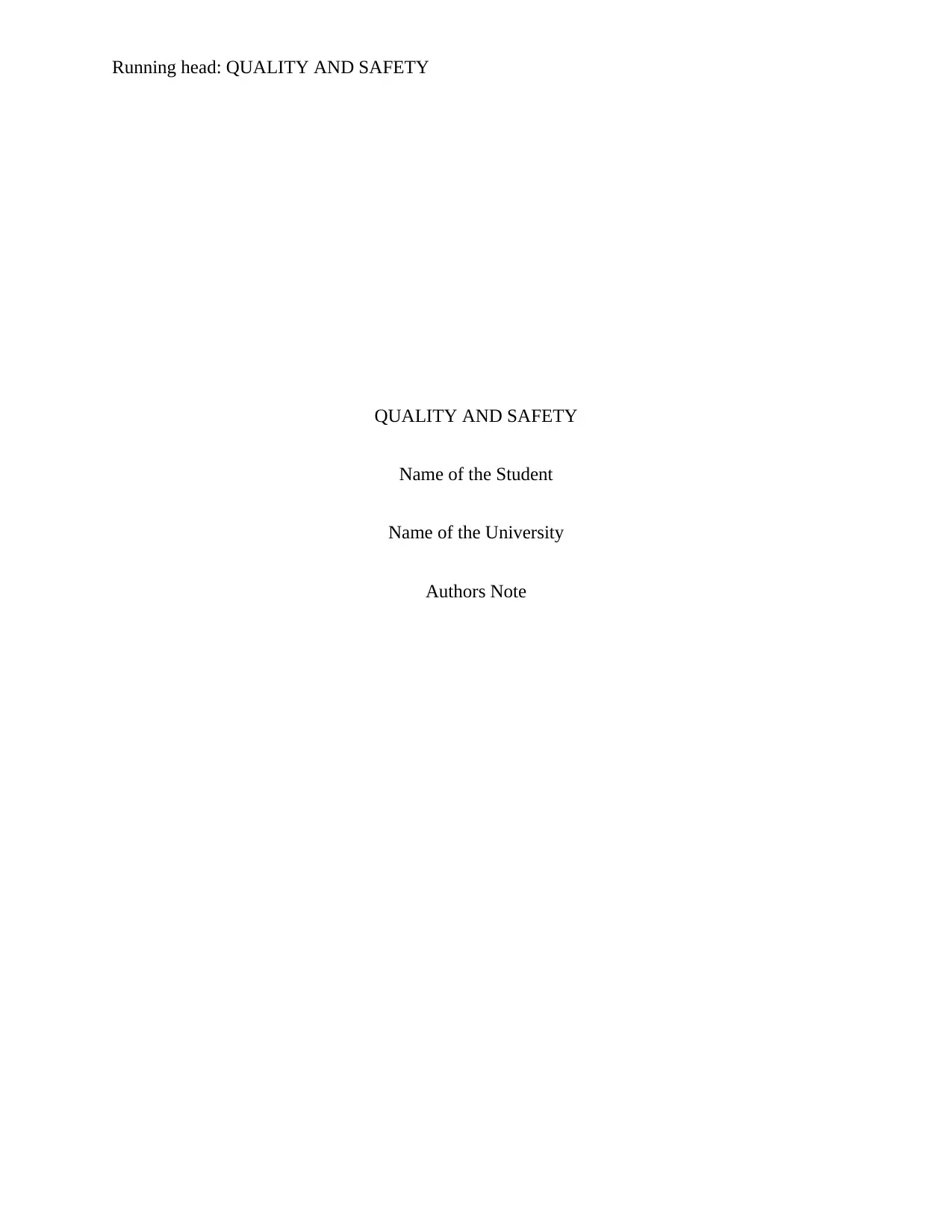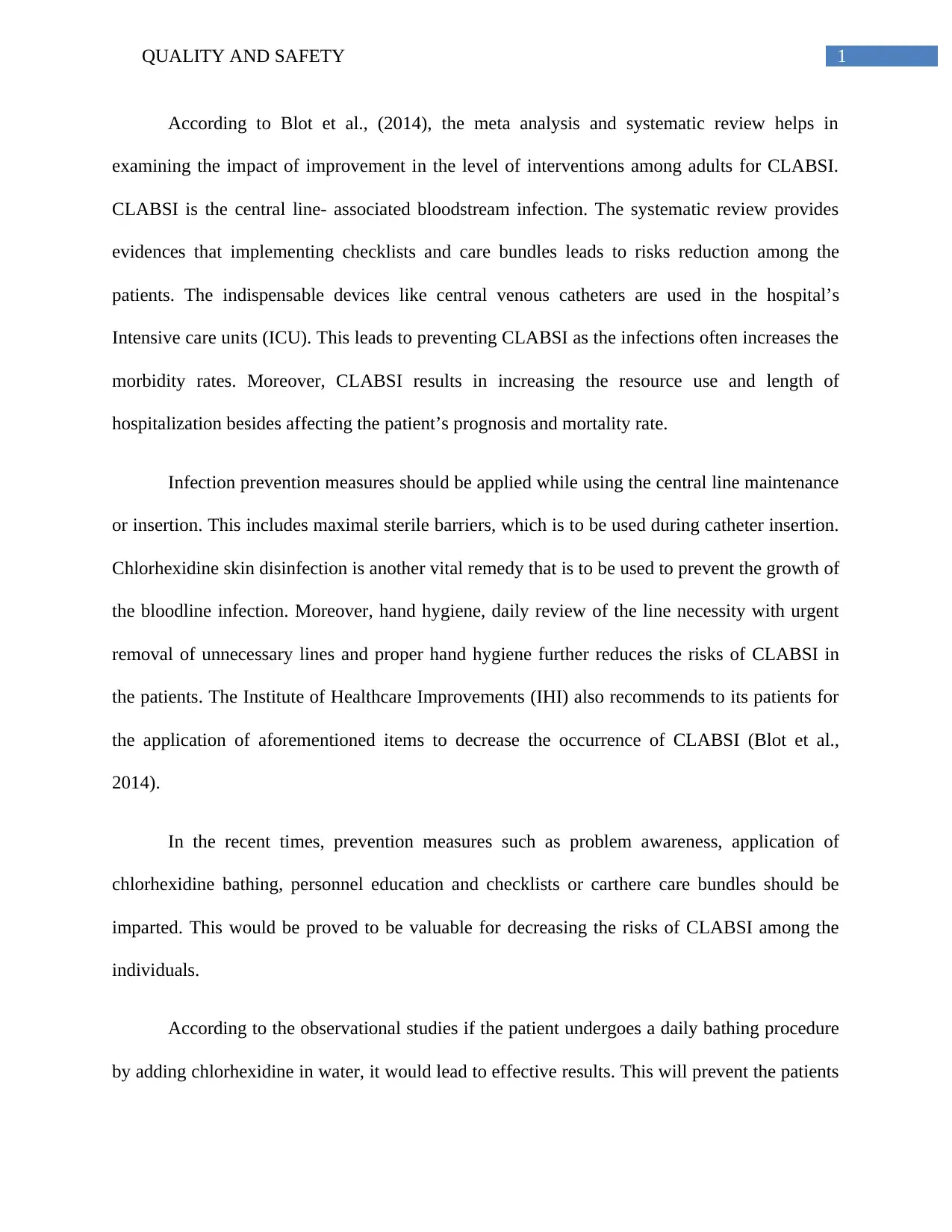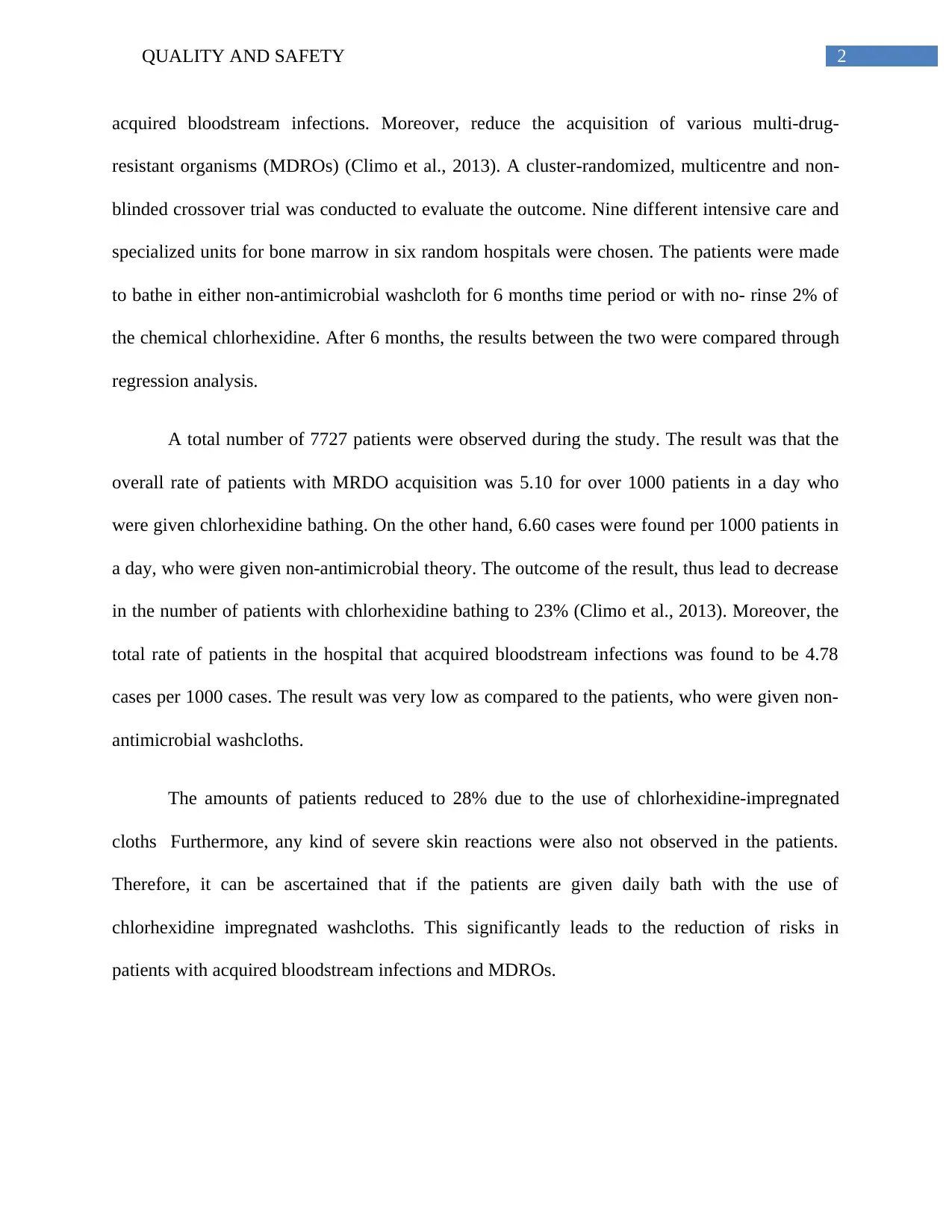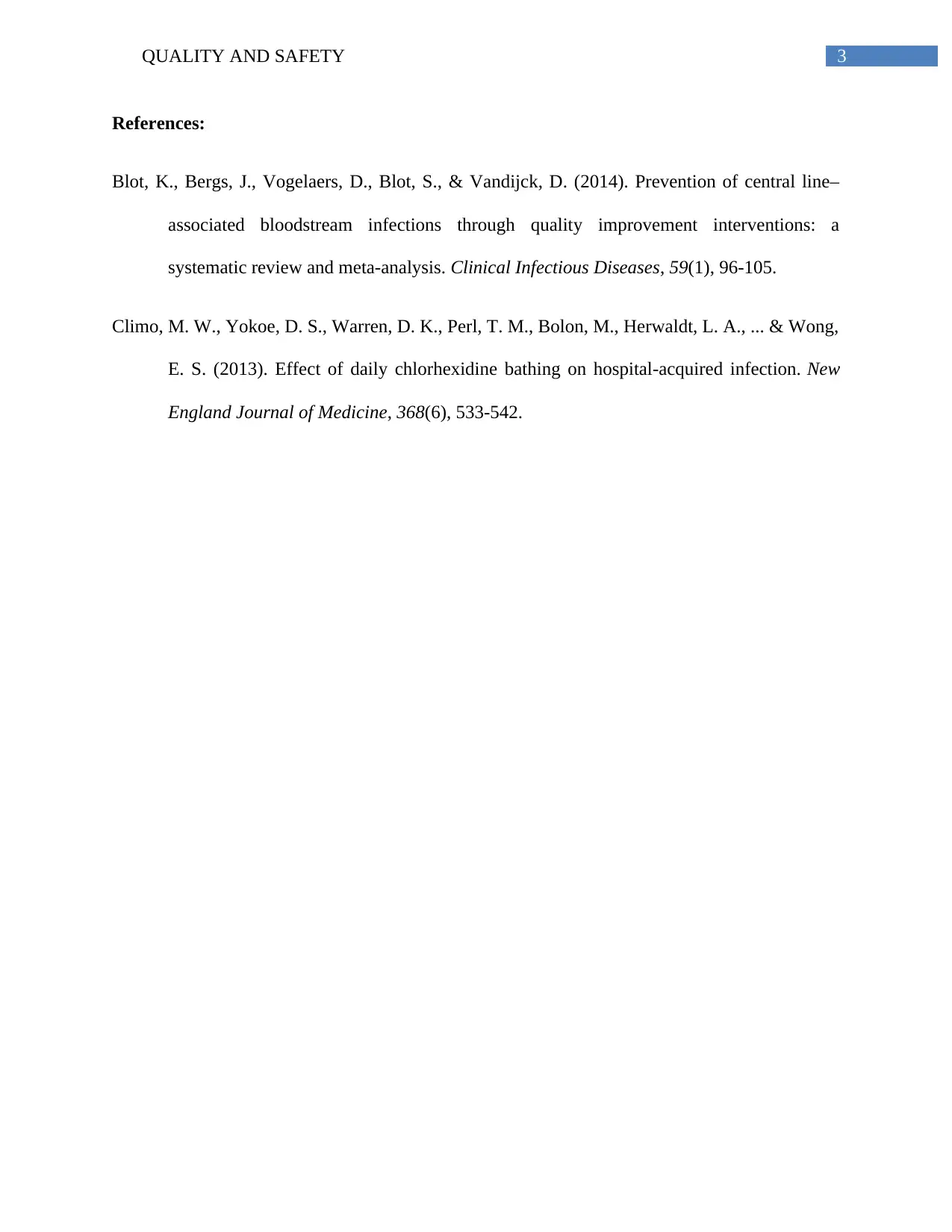Quality and Safety Report: CLABSI Prevention Through Interventions
VerifiedAdded on 2020/05/16
|4
|749
|136
Report
AI Summary
This report focuses on strategies to prevent Central Line-Associated Bloodstream Infections (CLABSI) in healthcare settings. It examines the effectiveness of interventions like checklists, care bundles, and chlorhexidine bathing. The report references studies and meta-analyses that highlight the importance of infection prevention measures, including maximal sterile barriers, hand hygiene, and daily review of line necessity. The study by Climo et al. (2013) is discussed, which shows a significant reduction in bloodstream infections and multi-drug-resistant organisms (MDROs) through daily chlorhexidine bathing. The report emphasizes the practical implications of these findings for improving patient safety and reducing morbidity and mortality associated with CLABSI.

Running head: QUALITY AND SAFETY
QUALITY AND SAFETY
Name of the Student
Name of the University
Authors Note
QUALITY AND SAFETY
Name of the Student
Name of the University
Authors Note
Paraphrase This Document
Need a fresh take? Get an instant paraphrase of this document with our AI Paraphraser

1QUALITY AND SAFETY
According to Blot et al., (2014), the meta analysis and systematic review helps in
examining the impact of improvement in the level of interventions among adults for CLABSI.
CLABSI is the central line- associated bloodstream infection. The systematic review provides
evidences that implementing checklists and care bundles leads to risks reduction among the
patients. The indispensable devices like central venous catheters are used in the hospital’s
Intensive care units (ICU). This leads to preventing CLABSI as the infections often increases the
morbidity rates. Moreover, CLABSI results in increasing the resource use and length of
hospitalization besides affecting the patient’s prognosis and mortality rate.
Infection prevention measures should be applied while using the central line maintenance
or insertion. This includes maximal sterile barriers, which is to be used during catheter insertion.
Chlorhexidine skin disinfection is another vital remedy that is to be used to prevent the growth of
the bloodline infection. Moreover, hand hygiene, daily review of the line necessity with urgent
removal of unnecessary lines and proper hand hygiene further reduces the risks of CLABSI in
the patients. The Institute of Healthcare Improvements (IHI) also recommends to its patients for
the application of aforementioned items to decrease the occurrence of CLABSI (Blot et al.,
2014).
In the recent times, prevention measures such as problem awareness, application of
chlorhexidine bathing, personnel education and checklists or carthere care bundles should be
imparted. This would be proved to be valuable for decreasing the risks of CLABSI among the
individuals.
According to the observational studies if the patient undergoes a daily bathing procedure
by adding chlorhexidine in water, it would lead to effective results. This will prevent the patients
According to Blot et al., (2014), the meta analysis and systematic review helps in
examining the impact of improvement in the level of interventions among adults for CLABSI.
CLABSI is the central line- associated bloodstream infection. The systematic review provides
evidences that implementing checklists and care bundles leads to risks reduction among the
patients. The indispensable devices like central venous catheters are used in the hospital’s
Intensive care units (ICU). This leads to preventing CLABSI as the infections often increases the
morbidity rates. Moreover, CLABSI results in increasing the resource use and length of
hospitalization besides affecting the patient’s prognosis and mortality rate.
Infection prevention measures should be applied while using the central line maintenance
or insertion. This includes maximal sterile barriers, which is to be used during catheter insertion.
Chlorhexidine skin disinfection is another vital remedy that is to be used to prevent the growth of
the bloodline infection. Moreover, hand hygiene, daily review of the line necessity with urgent
removal of unnecessary lines and proper hand hygiene further reduces the risks of CLABSI in
the patients. The Institute of Healthcare Improvements (IHI) also recommends to its patients for
the application of aforementioned items to decrease the occurrence of CLABSI (Blot et al.,
2014).
In the recent times, prevention measures such as problem awareness, application of
chlorhexidine bathing, personnel education and checklists or carthere care bundles should be
imparted. This would be proved to be valuable for decreasing the risks of CLABSI among the
individuals.
According to the observational studies if the patient undergoes a daily bathing procedure
by adding chlorhexidine in water, it would lead to effective results. This will prevent the patients

2QUALITY AND SAFETY
acquired bloodstream infections. Moreover, reduce the acquisition of various multi-drug-
resistant organisms (MDROs) (Climo et al., 2013). A cluster-randomized, multicentre and non-
blinded crossover trial was conducted to evaluate the outcome. Nine different intensive care and
specialized units for bone marrow in six random hospitals were chosen. The patients were made
to bathe in either non-antimicrobial washcloth for 6 months time period or with no- rinse 2% of
the chemical chlorhexidine. After 6 months, the results between the two were compared through
regression analysis.
A total number of 7727 patients were observed during the study. The result was that the
overall rate of patients with MRDO acquisition was 5.10 for over 1000 patients in a day who
were given chlorhexidine bathing. On the other hand, 6.60 cases were found per 1000 patients in
a day, who were given non-antimicrobial theory. The outcome of the result, thus lead to decrease
in the number of patients with chlorhexidine bathing to 23% (Climo et al., 2013). Moreover, the
total rate of patients in the hospital that acquired bloodstream infections was found to be 4.78
cases per 1000 cases. The result was very low as compared to the patients, who were given non-
antimicrobial washcloths.
The amounts of patients reduced to 28% due to the use of chlorhexidine-impregnated
cloths Furthermore, any kind of severe skin reactions were also not observed in the patients.
Therefore, it can be ascertained that if the patients are given daily bath with the use of
chlorhexidine impregnated washcloths. This significantly leads to the reduction of risks in
patients with acquired bloodstream infections and MDROs.
acquired bloodstream infections. Moreover, reduce the acquisition of various multi-drug-
resistant organisms (MDROs) (Climo et al., 2013). A cluster-randomized, multicentre and non-
blinded crossover trial was conducted to evaluate the outcome. Nine different intensive care and
specialized units for bone marrow in six random hospitals were chosen. The patients were made
to bathe in either non-antimicrobial washcloth for 6 months time period or with no- rinse 2% of
the chemical chlorhexidine. After 6 months, the results between the two were compared through
regression analysis.
A total number of 7727 patients were observed during the study. The result was that the
overall rate of patients with MRDO acquisition was 5.10 for over 1000 patients in a day who
were given chlorhexidine bathing. On the other hand, 6.60 cases were found per 1000 patients in
a day, who were given non-antimicrobial theory. The outcome of the result, thus lead to decrease
in the number of patients with chlorhexidine bathing to 23% (Climo et al., 2013). Moreover, the
total rate of patients in the hospital that acquired bloodstream infections was found to be 4.78
cases per 1000 cases. The result was very low as compared to the patients, who were given non-
antimicrobial washcloths.
The amounts of patients reduced to 28% due to the use of chlorhexidine-impregnated
cloths Furthermore, any kind of severe skin reactions were also not observed in the patients.
Therefore, it can be ascertained that if the patients are given daily bath with the use of
chlorhexidine impregnated washcloths. This significantly leads to the reduction of risks in
patients with acquired bloodstream infections and MDROs.
⊘ This is a preview!⊘
Do you want full access?
Subscribe today to unlock all pages.

Trusted by 1+ million students worldwide

3QUALITY AND SAFETY
References:
Blot, K., Bergs, J., Vogelaers, D., Blot, S., & Vandijck, D. (2014). Prevention of central line–
associated bloodstream infections through quality improvement interventions: a
systematic review and meta-analysis. Clinical Infectious Diseases, 59(1), 96-105.
Climo, M. W., Yokoe, D. S., Warren, D. K., Perl, T. M., Bolon, M., Herwaldt, L. A., ... & Wong,
E. S. (2013). Effect of daily chlorhexidine bathing on hospital-acquired infection. New
England Journal of Medicine, 368(6), 533-542.
References:
Blot, K., Bergs, J., Vogelaers, D., Blot, S., & Vandijck, D. (2014). Prevention of central line–
associated bloodstream infections through quality improvement interventions: a
systematic review and meta-analysis. Clinical Infectious Diseases, 59(1), 96-105.
Climo, M. W., Yokoe, D. S., Warren, D. K., Perl, T. M., Bolon, M., Herwaldt, L. A., ... & Wong,
E. S. (2013). Effect of daily chlorhexidine bathing on hospital-acquired infection. New
England Journal of Medicine, 368(6), 533-542.
1 out of 4
Related Documents
Your All-in-One AI-Powered Toolkit for Academic Success.
+13062052269
info@desklib.com
Available 24*7 on WhatsApp / Email
![[object Object]](/_next/static/media/star-bottom.7253800d.svg)
Unlock your academic potential
Copyright © 2020–2025 A2Z Services. All Rights Reserved. Developed and managed by ZUCOL.





